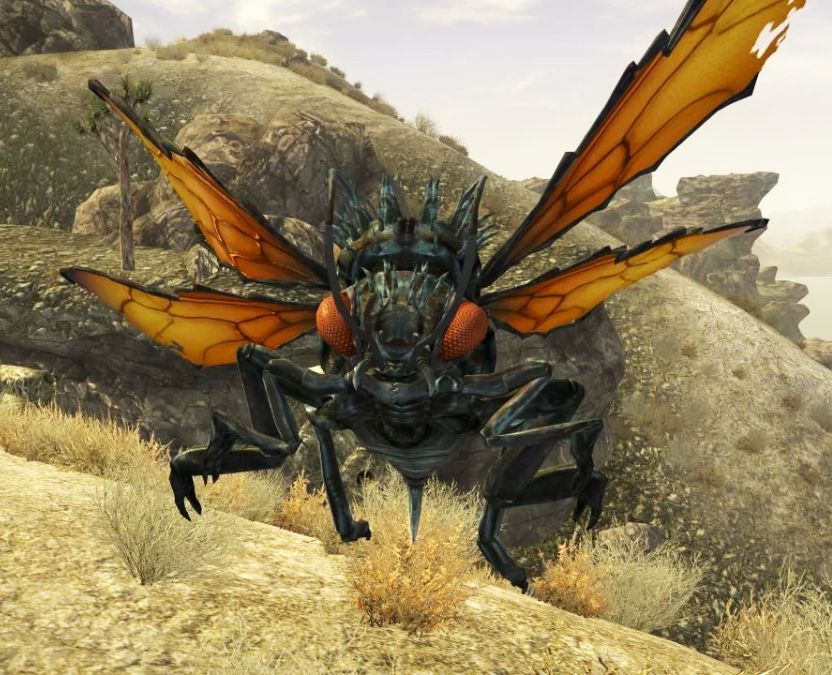Difference between revisions of "Giant Insect (spell)"
Tao alexis (talk | contribs) |
Tao alexis (talk | contribs) |
||
| Line 1: | Line 1: | ||
[[File:Giant Insect (spell) B.jpg|right|525px|thumb]] | [[File:Giant Insect (spell) B.jpg|right|525px|thumb]] | ||
| − | '''Giant insect''' enables the caster to transform ordinary-sized insects and arachnids into their giant forms. The possibility exists for creating giant insects that exist in the game's [[Bestiary|bestiary]] and some that don't; the DM must use sense in determining the attack forms and power of insects for which no stats exist. | + | '''Giant insect''' enables the caster to transform ordinary-sized [[Insect|insects]] and [[Arachnid|arachnids]] into their giant forms. The possibility exists for creating giant insects that exist in the game's [[Bestiary|bestiary]] and some that don't; the DM must use sense in determining the attack forms and power of insects for which no stats exist. |
{{Spelltable | {{Spelltable | ||
Revision as of 20:45, 30 December 2021
Giant insect enables the caster to transform ordinary-sized insects and arachnids into their giant forms. The possibility exists for creating giant insects that exist in the game's bestiary and some that don't; the DM must use sense in determining the attack forms and power of insects for which no stats exist.
| Range | 20 ft. |
| Duration | 2 rounds per level |
| Area of Effect | 2 hit dice per level |
| Casting Time | 2 rounds |
| Saving Throw | none |
| Level | cleric (4th) |
The caster must be able to see the insect being transformed; if caught and contained in a glass jar, the spell will cause the enlarged insects to shatter the container upon growth, at no harm to themselves.
Hit Dice Designation
The maximum hit die (HD) for each type of enlarged insect depends on its monstrous form. For example, giant wasps normally have 4 HD; therefore, a 10th level caster could create twenty wasps of 1 HD each, or ten wasps of 2 HD each, or some other combination, so long as no created giant wasp had more than 4 HD.
In each case, the amount of attack damage the insect causes is calculated thusly: for each HD less than the original, the "die" is reduced by one degree, or -1 maximum damage.
- For example, the 4 HD wasp normally causes 2-8 damage with its pincers. A 3 HD wasp could do, at best, 7 damage on a normal hit, and therefore causes 2-7 with its pincers. A 2 HD wasp would cause 1-6 and a 1 HD wasp would cause 2-5. Many smaller wasps might therefore cause more damage — but they would be more easily stunned or killed, and would suffer from a lower THAC0.
Hostility
Because insects lack any sort of intelligence, the caster has no control over them whatsoever. Once enlarged, they'll be furious, ravenous and bound to attack whatever target comes immediately to hand — including the caster and associated allies. Therefore steps should be taken to seek immediate cover, letting the giant insects wreak havoc and perhaps cause a distraction.
Once their usefulness is gone, the caster can dispel the effects at will, reducing any remaining insects to their normal size. If some insect become a danger, the dweomer can be removed from each insect individually.
Enhancing Giant Forms
The spell can be cast upon existing giant insects, in which case the original will be increased to 50% it's normal size. This effect cannot be adjusted up or down; a giant wasp will always be increased to 6 HD, with 50% more hit points. Moreover, once the spell is used in this fashion, the effect on the giant insect cannot be dispelled — if it becomes dangerous, it must be killed or suffered somehow until the spell's duration runs out.
